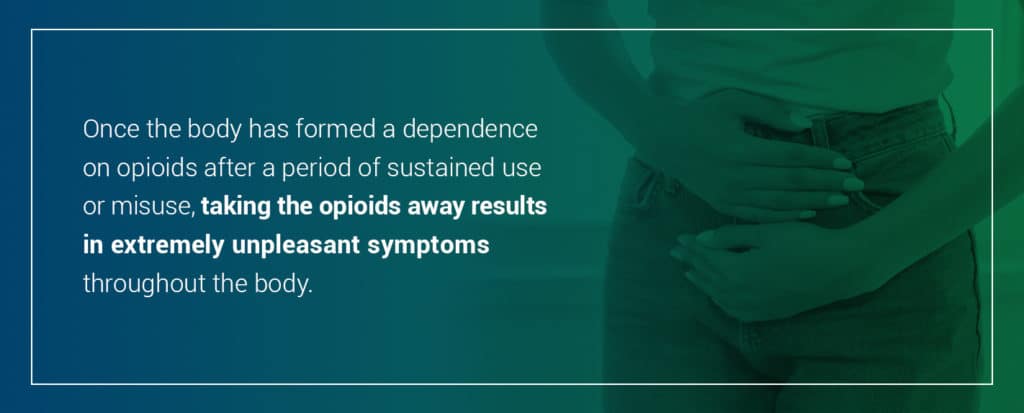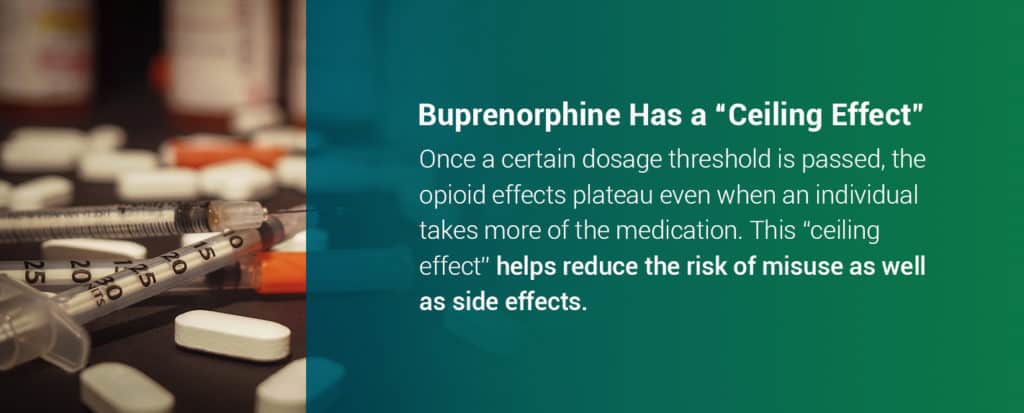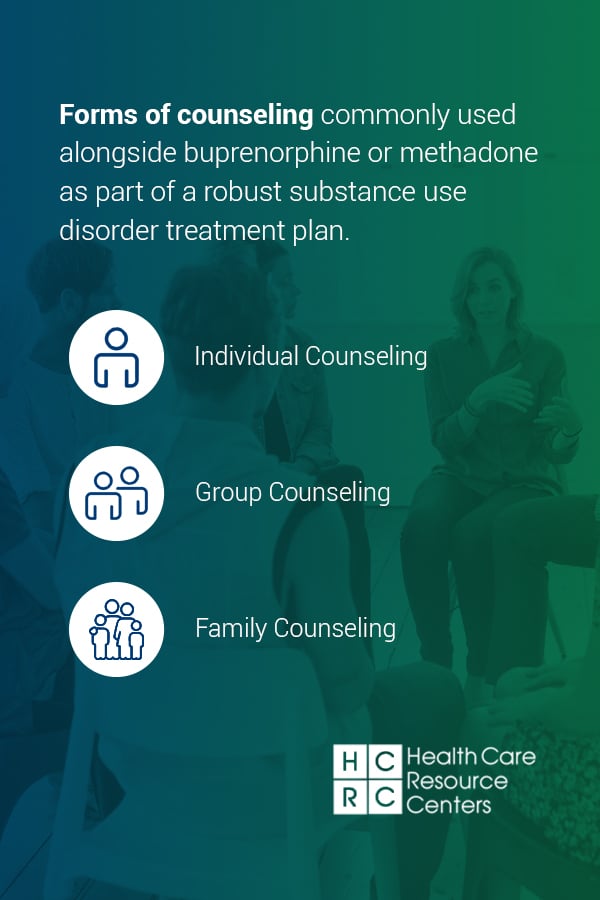When you’re considering treatment options for opioid addiction, medication-assisted treatment (MAT) will be one of the common programs you encounter. MAT is an effective option for many individuals, and there are two primary medications used in such programs — methadone and buprenorphine.
Both medications are proven effective in treating opioid use disorder. We’ll break down the similarities as well as the differences between the two that may make one medication more suitable for you than the other.
Methadone vs. Buprenorphine Similarities
These two medications have more in common with each other than they have differences. Here are the essential similarities between methadone and buprenorphine.
1. Doctors Prescribe Them for the Same Reasons
The purpose of an MAT program is to prevent participants from experiencing withdrawal symptoms or cravings, allowing them to focus on addressing the other elements of recovery through counseling. Once the body has formed a dependence on opioids after a period of sustained use or misuse, taking the opioids away results in extremely unpleasant symptoms throughout the body, including:
- Anxiety and agitation
- Muscle aches and cramping
- Insomnia
- Yawning
- Sweating
- Abdominal cramping and diarrhea
- Nausea and vomiting
- Goosebumps
When these symptoms strike, an addicted individual is often in so much discomfort that all they can think of is obtaining and using more opioids to make the pain stop. Both methadone and buprenorphine are designed to stop the worst of these symptoms from happening in the first place, so recipients can function with relative normality and participate fully in their treatment.
2. They’re Both Opioids
Both methadone and buprenorphine are opioids. Buprenorphine is a semi-synthetic compound, being made from both natural and synthetic compounds, while methadone is a fully-synthetic compound. Both prevent withdrawal symptoms by interacting with opioid receptors in the brain.
3. They Have Similar Side Effects
As opioids, methadone and buprenorphine come with a list of possible side effects to their use. The shared side effects of both treatments include:
- Lightheadedness
- Dizziness
- Sleepiness
- Nausea and vomiting
- Sweating
- Constipation
These side effects are generally mild and may subside after a person’s dosage stabilizes.
4. You Can Use Them as Maintenance Medications
Maintenance treatment involves taking medication consistently over the long term to maintain sobriety. Many people choose to remain on their medication indefinitely because it allows them to live a life free of opioid cravings.
Without the extreme craving for drugs, people can stop the destructive behaviors that characterize addiction, such as compulsive drug-seeking and inability to control opioid use. Both methadone and buprenorphine are suitable for long-term maintenance treatment.
[maxbutton id=”2″ text=”Find A Treatment Center Near You” url=”https://www.hcrcenters.com/our-location/”]
Methadone vs. Buprenorphine Differences
While these medications are prescribed for the same reasons and lead to the same outcomes when used successfully, there are many significant differences that can influence your treatment choice.
1. Methadone Is Older
Methadone has been around for much longer than buprenorphine, giving us a far larger body of scientific studies about it. Methadone came to the United States in 1947, when it was used to as a pain reliever. When heroin addiction surged in the early 1960s, researchers found that providing methadone to addicted individuals was an effective way to keep them from using heroin. By 1972, methadone was regulated for addiction treatment. It has been considered the gold standard for MAT ever since.
Buprenorphine is very new by comparison. The Food and Drug Administration (FDA) approved it for use in MAT in late 2002.
2. Buprenorphine Has a “Ceiling Effect”
Methadone is a full opioid agonist. It binds fully to mu-opioid receptors allowing it’s effects to be felt fully, and increase as the dose increases. Buprenorphine is a partial mu-opioid agonist, so while it binds fully to receptors, it does not produce the same intensity of effect as methadone and other full agonists.
Most importantly, buprenorphine’s effects only increase up to a certain point. Once a certain dosage threshold is passed, the opioid effects plateau even when an individual takes more of the medication. This “ceiling effect” helps reduce the risk of misuse as well as side effects.
The ceiling effect makes buprenorphine a safer option than methadone for people with a mild to moderate opioid use disorder, but also makes it less effective for those who have used extremely high concentrations of opioids.
3. Buprenorphine Comes in Abuse-Deterrent Formulas
Buprenorphine’s development was partially a response to the abuse potential of methadone. While taking methadone as prescribed does not lead to a euphoric “high,” it can be abused — especially if an individual doesn’t have a history of opioid use disorder.
Buprenorphine’s ceiling effect helps deter abuse, but manufacturers decided to increase the deterrent effects by introducing naloxone to the formula. Naloxone is an opioid antagonist used to treat opioid overdoses in emergencies. It quickly reverses the symptoms and can save lives in emergencies.
When added to buprenorphine, naloxone makes abusing the medication extremely unpleasant. If someone crushes up a tablet or dissolves a sublingual strip for injection, the naloxone will cause them to go into withdrawal immediately. Additionally, it prevents other opioids from acting on the receptors in the brain — so if someone attempts to take another opioid immediately afterward, they will not experience any of its effects.
Name brands for buprenorphine and naloxone combination medications include Suboxone® and Zubsolv®. These medications are a good choice for someone who has a history of relapse or is concerned about their relapse potential.
4. You Can Take Buprenorphine Home
Methadone is categorized as a Schedule II drug by the DEA, which means it is highly regulated and can only be dispensed at licensed clinics. Thanks to its lower potential for abuse, buprenorphine is categorized as a Schedule III drug. Physicians can prescribe buprenorphine for patients to take home from the beginning of their treatment. In an office-based opioid treatment (OBOT) program, participants visit a doctor or nurse practitioner in a typical office setting to receive a prescription which they then fill at any pharmacy.
Methadone programs require participants to visit a clinic daily to receive their medication early in treatment. Only after meeting strict federal and state requirements can they qualify for take-home medication, but checks and balances remain in place to ensure the medication is being used safely and properly. After being in treatment for one full year, the maximum amount of methadone allowed to be taken home is a two-week supply. This arrangement can be helpful for fostering accountability, but it may be too disruptive to work well for some people.
People who wish to continue working or attending school during treatment will find OBOT with buprenorphine is easier to work into their schedule.
5. Methadone Is More Affordable
Cost is often a factor in deciding which treatment route to take. Due to its relative newness, buprenorphine is more expensive than methadone. Buprenorphine-naloxone formulations are at the top of the medication cost charts. If you plan to use buprenorphine temporarily and taper off, the extra expense may even out in the long run compared to using methadone for indefinite maintenance.
Patient Retention With Methadone vs. Buprenorphine
When considering treatments, it’s important to know their potential for success. With MAT, one critical measure of efficacy is how long people continue their treatment. So, is patient retention better with methadone or buprenorphine? The first significant U.S. study comparing patient retention was published in 2014 and found that methadone has much higher treatment retention than buprenorphine, although both are equally as effective at keeping people from illicitly using opioids.
These three key findings shed more light on the discrepancy:
- More buprenorphine patients (25%) dropped out of treatment within the first 30 days than methadone patients (8%).
- More methadone patients (74%) completed treatment than buprenorphine patients (46%).
- Buprenorphine patients were 50% less likely to stay in treatment after 24 weeks.
The study also found that increasing the medication dosage in the buprenorphine group resulted in lower opioid use and better retention. The study’s daily maximum was only 32mg of buprenorphine daily. One of the investigations cited in the study found that taking as much as 56mg of buprenorphine daily was associated with a 92% retention rate at 30 months of treatment.
Other, smaller studies have come up with mixed results on buprenorphine treatment retention. As a newer drug, there is less evidence to compare with the large body of research on methadone. Part of the reason buprenorphine is sometimes shown to have lower retention rates might be the take-home aspect of the treatment, but current evidence does not conclusively show that this is the case.
Buprenorphine vs. Methadone in Pregnancy
A critical question is which medication a woman should take while pregnant. It’s crucial for a woman to avoid opioid withdrawal during pregnancy, as it can cause the uterus to contract. When this happens, there is a significant risk of miscarriage or premature birth. Pregnant women have been safely and successfully taking methadone to prevent withdrawal symptoms through pregnancy for decades.
Despite the common misconception that methadone can cross the placenta and cause problems in utero, methadone does not cause birth defects. Some babies may experience withdrawal after being born, but it doesn’t mean they are addicted.
New moms participating in methadone maintenance treatment can still breastfeed. The amount of methadone that transfers to breast milk is negligible, and the benefits of breastfeeding for the baby far outweigh the small risk.
The American College of Obstetricians and Gynecologists (ACOG) recommends buprenorphine for treating pregnant women. It has fewer drug interactions and has demonstrated less need for dosage changes throughout the pregnancy. Being able to take home the medication is also advantageous.
Both medications are safe and effective for pregnant women, though there is much less evidence of this fact for buprenorphine and many medical providers prefer patients use methadone during a pregnancy. It’s important to note that a pregnant woman taking methadone shouldn’t transition to buprenorphine as there is a significant risk of triggering withdrawal. Transitioning from buprenorphine to methadone does not carry this risk.
The Role of Buprenorphine and Methadone in MAT
Every major body of research shows that medication-assisted treatment works best when combined with counseling and behavioral therapy. Taking a whole-patient approach to addiction treatment increases a person’s ability to sustain their recovery.
The following forms of counseling are commonly used alongside buprenorphine or methadone as part of a robust substance use disorder treatment plan.
1. Individual Counseling
Substance use disorders are highly personal, and part of the work of recovery is unraveling internal motivations and thought processes. One-on-one counseling offers individuals assistance with a range of psychological and emotional goals including:
- Modifying thoughts and attitudes toward opioids and other substances.
- Providing space to talk about emotional, psychological or spiritual issues caused by traumas.
- Providing a set of tools and strategies for dealing with life’s ups and downs.
- Creating a foundation for reconnection with friends, family and society.
- Teaching patients about the science behind addiction and recovery.
2. Group Counseling
Entering a substance abuse treatment program can often make a person feel isolated and alone. Group counseling offers a way to engage with others in similar circumstances and forge a sense of belonging. Group therapy allows participants to share their experiences as well as the positive tools they’ve learned.
The group setting helps alleviate feelings of shame that may hinder progress and encourages participants to support each other. After treatment has been completed, it’s recommended that people in recovery continue group work in the form of programs like Narcotics Anonymous.
3. Family Counseling
Substance abuse and addiction cause people to behave in selfish and unpredictable ways that can easily cause harm to family relationships. Family counseling helps foster new trust and develop stronger relationships. It also helps family members identify and stop enabling behaviors while teaching the patient to recognize the effects of their behavior.
Getting Started With MAT
Starting treatment with methadone or buprenorphine feels less overwhelming when you know what to expect. When you come to any of the Health Care Resource Centers (HCRC) located in New England, you can expect a customer-focused experience with your health and recovery in mind. The first step is to complete an intake appointment with medical and clinical components. During intake, you will participate in:
- A comprehensive review of your substance abuse history.
- A urinalysis screening for opioids and other drugs.
- A physical examination and review of your medical history.
- Any required referrals for medical or psychiatric treatment.
Upon completing these, you’ll receive an orientation that goes over the program’s policies and procedures to ensure you understand your treatment and your expected role in it. As you begin treatment, you’ll work with a counselor to tailor the program to your individual needs.
Choose Health Care Resource Centers
Deciding to get help for a substance use disorder is one of the bravest things anyone can do. Addiction to opioids has immense negative impacts on your mental and physical health in both the short and long term, so the sooner you choose recovery, the sooner you can heal.
HCRC has been providing medication-assisted treatment for opioid use disorder for more than 25 years. Our certified, licensed and accredited programs use evidence-based techniques to give patients the strongest foundation for recovery.
If you’re interested in treatment using buprenorphine or methadone, HCRC is ready to answer your questions. You can speak with one of our friendly and knowledgeable representatives about both medications and which one may be the better option for you. Give HCRC a call today at (866) 758-7769 or contact us online to learn more about how medication-assisted treatment can put you on the path to recovery.








